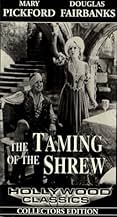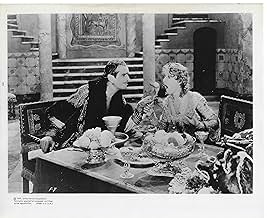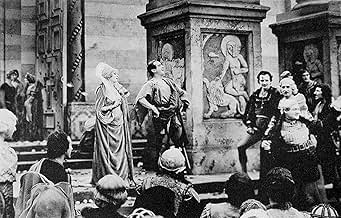Füge eine Handlung in deiner Sprache hinzuIn sixteenth century Padua, Hortensio loves Bianca, the youngest daughter of Baptista. But Baptista will not allow the two to get married until his eldest daughter, the extremely headstrong ... Alles lesenIn sixteenth century Padua, Hortensio loves Bianca, the youngest daughter of Baptista. But Baptista will not allow the two to get married until his eldest daughter, the extremely headstrong Katherine, is betrothed. This task seems impossible because of Katherine's shrewish demean... Alles lesenIn sixteenth century Padua, Hortensio loves Bianca, the youngest daughter of Baptista. But Baptista will not allow the two to get married until his eldest daughter, the extremely headstrong Katherine, is betrothed. This task seems impossible because of Katherine's shrewish demeanor. They believe their prayers have been answered with the arrival from Verona of the lust... Alles lesen
- Regie
- Drehbuch
- Hauptbesetzung
- Auszeichnungen
- 2 wins total
- Servant
- (Nicht genannt)
- Little Boy
- (Nicht genannt)
- Little Girl
- (Nicht genannt)
- Servant
- (Nicht genannt)
Empfohlene Bewertungen
The movie was a vehicle for real-life husband and wife Douglas Fairbanks and Mary Pickford, he in his first talkie, she in her second. Given the state that their marriage had degenerated into by this point, the storminess between the two of them probably wasn't that far from the truth. They both act well it has to be said, hamming it up magnificently in a manner drawing upon their experience both in stage and silent cinema, and which you can only really get away with in the context of this play's comical theatricality.
The director is Sam Taylor, a man with a background in comedy, who helmed the finest Harold Lloyd movies during the silent era. The Taming of the Shrew sees him returning to his roots, staging the verbal comedy as broad slapstick. Taylor is a master of the pull-back-and-reveal gag, making us think one thing then punch-lining us with another. In adapting the play, he pares down Shakespeare's dialogue, and reduces it for the most part to a poetic backdrop, allowing the comic vignettes to tell the story. This is quite something, because this style of physical comedy more or less died out when the talkies came along, but here Sam Taylor is showing a way it could have continued.
But what is also intriguingly good about this version of The Taming of the Shrew is its sly subversion of Shakespeare's misogyny. The bard's lines remain what they are, but the action in between them is enough to tweak their message. Pickford is brilliantly sarcastic for Katherine's final speech, and as Fairbanks sits beside her with a large bandage on his head, it becomes clear who's taming whom.
Variety was upbeat on "The Taming of the Shrew," commenting "While there is plenty of romance and dialog, slapstick and mud, there's no dirt, so that part of Pickford's career remains as clean as ever. Splendid settings in the Fairbanks massive production manner." Modern assessments of the film are less than praiseworthy, especially knowing in hindsight that both careers took a deep dive after the "Shrew." Says Leonard Maltin, the movie "was defeated by its lack of pacing and downright embarrassing performances, though it's undeniably fascinating to see Doug and Mary together in their only co-starring appearance." Years later, Pickford said it was her worst performance of her life. She did admit, however, that Fairbanks excelled as his portrayal of Petruchio.
"The Taming of the Shrew" was the first Shakespearian play brought to the screen as a talkie. The feature film was based more on the Richard Garrick's version of the farce, his 'Katherine and Petruchio.' The 1929 film incorporates about 20 percent of Shakespeare's written dialogue, and the movie's English, still Elizabethan, is updated somewhat to make it more understandable for the modern audiences.
Today's viewers to "The Taming of the Shrew" will take notice that Fairbanks' harsh treatment of Katherine is so over-the-top many felt back then the actor was taking out all his frustrations of the couple's personal relationship out on her. And Pickford's punchy attitude was equally demonstrative by her excessive yelling and physicality towards him, portions that were not written in the script. Pickford claims all the fault laid at the director, Sam Taylor's feet, a surprising allegation since both he and the actress got along swimmingly during their last collaboration, 1927's "My Best Girl."
As one reviewer noted, "The acting that had made Pickford and Fairbanks the 'King and Queen of Hollywood' rendered their performing style obsolete overnight. It's important to remember, of course, that the change brought about by sound had absolutely nothing to do with their deficiencies as performers, but only emphasizes the differences between silent and sound film. Watching a film like 'The Taming of the Shrew,' and comparing it to what they were both doing just months earlier, makes a strong case that the silent and sound film are really two entirely different things."
Hollywood royalty Douglas Fairbanks and Mary Pickford star as Kate and Petruchio, the warring couple who really love each other on the sly. Their marriage was a sham by the time this flick came out, and both their careers were on the wane, but they give reasonable enough performances, even though Fairbanks looks a few years too old for his part when the camera gets close. There's still a tendency to exaggerate their gestures and overact to responses to words being spoken, but they're no worse than any other stars making their first sound films.
It's clear that Hollywood back then had no more confidence in the intelligence of its audience than it does today: this is Shakespeare for the common man, with the pith of the Bard's prose removed in order to make the words readily understandable to all. Although the film is little more than an hour long, it does begin to drag during the last twenty minutes but, that aside, it's not a bad effort.
Wusstest du schon
- WissenswertesIn her later years, Mary Pickford stated that working on the film was the worst experience of her life, although she also acknowledged that Douglas Fairbanks's performance was one of his best.
- Alternative VersionenAfter many years out of circulation, the film was re-released in 1966 in a new cut supervised by Mary Pickford herself. New sound effects were added throughout, much of the voice dubbing was enhanced with newly available technology, and seven minutes were cut from the initial print. This re-released version is the only version now available on DVD or VHS.
- VerbindungenFeatured in Mary Pickford: A Life on Film (1997)
Top-Auswahl
Details
- Erscheinungsdatum
- Herkunftsland
- Sprache
- Auch bekannt als
- The Taming of the Shrew
- Drehorte
- Produktionsfirmen
- Weitere beteiligte Unternehmen bei IMDbPro anzeigen
Box Office
- Budget
- 504.000 $ (geschätzt)
- Laufzeit
- 1 Std. 3 Min.(63 min)
- Farbe

















